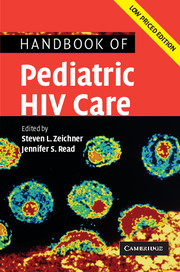Book contents
- Frontmatter
- Contents
- List of contributors
- List of abbreviations
- Foreword
- Preface
- Part I Scientific basis of pediatric HIV care
- Part II General issues in the care of pediatric HIV patients
- 3 Diagnosis of HIV infection in children
- 4 Prevention of mother-to-child transmission of HIV
- 5 Routine pediatric care
- 6 Emergency evaluation and care
- 7 Adherence to antiretroviral therapy in children and youth
- 8 Adolescents and HIV
- 9 Growth, nutrition, and metabolism
- 10 Neurobehavioral function and assessment of children and adolescents with HIV infection
- Part III Antiretroviral therapy
- Part IV Clinical manifestations of HIV infection in children
- Part V Infectious problems in pediatric HIV disease
- Part VI Medical, social, and legal issues
- Appendix 1 Formulary of antiretroviral agents
- Appendix 2 National Institutes of Health sponsored clinical trials for pediatric HIV disease
- Appendix 3 Selected HIV-related internet resources
- Appendix 4 Selected legal resources for HIV-infected children
- Index
- References
10 - Neurobehavioral function and assessment of children and adolescents with HIV infection
Published online by Cambridge University Press: 23 December 2009
- Frontmatter
- Contents
- List of contributors
- List of abbreviations
- Foreword
- Preface
- Part I Scientific basis of pediatric HIV care
- Part II General issues in the care of pediatric HIV patients
- 3 Diagnosis of HIV infection in children
- 4 Prevention of mother-to-child transmission of HIV
- 5 Routine pediatric care
- 6 Emergency evaluation and care
- 7 Adherence to antiretroviral therapy in children and youth
- 8 Adolescents and HIV
- 9 Growth, nutrition, and metabolism
- 10 Neurobehavioral function and assessment of children and adolescents with HIV infection
- Part III Antiretroviral therapy
- Part IV Clinical manifestations of HIV infection in children
- Part V Infectious problems in pediatric HIV disease
- Part VI Medical, social, and legal issues
- Appendix 1 Formulary of antiretroviral agents
- Appendix 2 National Institutes of Health sponsored clinical trials for pediatric HIV disease
- Appendix 3 Selected HIV-related internet resources
- Appendix 4 Selected legal resources for HIV-infected children
- Index
- References
Summary
Children infected with human immunodeficiency virus-type 1 (HIV-1) are at increased risk for central nervous system (CNS) disease characterized by cognitive, language, motor, and behavioral impairments. The severity of HIV-related CNS manifestations in children ranges from subtle impairments in selective domains to severe deterioration of global developmental skills.
HIV-related CNS dysfunction in children is primarily the result of HIV-1 infection in the brain [1, 2]. Various host or viral neurotoxic factors are postulated as the main cause of neurologic damage as neurons seem to remain largely uninfected [1, 3]. Secondary CNS complications due to immune deficiency, such as brain tumors, other infections, or cerebrovascular diseases, also may cause CNS manifestations but are less common and usually occur in older children [4].
Early in the epidemic, approximately 50% to 90% of children with HIV-1 infection exhibited severe CNS manifestations [5, 6] termed HIV encephalopathy. More recent studies, however, report that the prevalence of encephalopathy in HIV-infected children is approximately 13% to 23% percent [7–10]. This decline in the prevalence of severe HIV-related CNS manifestations may be related in part to the earlier and more generalized use of combination antiretroviral treatment (ART), including highly active antiretroviral therapy (HAART) [11–14]. HAART is effective in suppressing systemic viral replication [15], which in turn may reduce the number of HIV-infected cells entering the CNS. However, the CNS is a separate compartment from the rest of the body and it may serve as a reservoir for persistent HIV-1 infection [16].
- Type
- Chapter
- Information
- Handbook of Pediatric HIV Care , pp. 309 - 332Publisher: Cambridge University PressPrint publication year: 2006
References
- 1
- Cited by



